Derivatives of Differentiation-Inducing Factor 1 Differentially Control Chemotaxis and Stalk Cell Differentiation in Dictyostelium discoideum
Abstract
Simple Summary
Abstract
1. Introduction
2. Materials and Methods
2.1. Strains and Reagents
2.2. Assay for In Vitro Stalk Cell Differentiation
2.3. Assay for Chemotaxis
2.4. Statistical Analysis
3. Results
3.1. Effects of DIFs (100 nM) on Chemotaxis in Ax2, gbpB−, and regA− Cells
3.2. Effects of DIFs (10 nM) on Chemotaxis in Ax2, regA−, rdeA−, and dhkC− Cells
3.3. Effects of DIFs on Stalk Cell Formation in HM1030 Cells
4. Discussion
4.1. Toward Identification of Receptors for DIF-1 and DIF-2
4.2. Utility of DIF Derivatives in the Study of Dictyostelium Development
5. Conclusions
Author Contributions
Funding
Institutional Review Board Statement
Informed Consent Statement
Data Availability Statement
Acknowledgments
Conflicts of Interest
References
- Konijn, T.M.; van de Meene, J.G.C.; Bonner, J.T.; Barkley, D.S. The acrasin activity of adenosine-3′,5′-cyclic phosphate. Proc. Natl. Acad. Sci. USA 1967, 58, 1152–1154. [Google Scholar] [CrossRef] [PubMed]
- Darmon, M.; Brachet, P.; Pereira da Silva, L.H. Chemotactic signals induce cell differentiation in Dictyostelium discoideum. Proc. Natl. Acad. Sci. USA 1975, 72, 3163–3166. [Google Scholar] [CrossRef]
- Devreotes, P. Dictyostelium discoideum: A model system for cell-cell interactions in development. Science 1989, 245, 1054–1058. [Google Scholar] [CrossRef]
- Morris, H.R.; Taylor, G.W.; Masento, M.S.; Jermyn, K.A.; Kay, R.R. Chemical structure of the morphogen differentiation inducing factor from Dictyostelium discoideum. Nature 1987, 328, 811–814. [Google Scholar] [CrossRef]
- Morris, H.R.; Masento, M.S.; Taylor, G.W.; Jermyn, K.A.; Kay, R.R. Structure elucidation of two differentiation inducing factors (DIF-2 and DIF-3) from the cellular slime mould Dictyostelium discoideum. Biochem. J. 1988, 249, 903–906. [Google Scholar] [CrossRef] [PubMed]
- Kay, R.R.; Berks, M.; Traynor, D. Morphogen hunting in Dictyostelium. Development 1989, 107, 81–90. [Google Scholar] [CrossRef]
- Kay, R.R.; Flatman, P.; Thompson, C.R.L. DIF signalling and cell fate. Semin. Cell Dev. Biol. 1999, 10, 577–585. [Google Scholar] [CrossRef] [PubMed]
- Masento, M.S.; Morris, H.R.; Taylor, G.W.; Johnson, S.J.; Skapski, A.C.; Kay, R.R. Differentiation-inducing factor from the slime mould Dictyostelium discoideum and its analogues. Biochem. J. 1988, 256, 23–28. [Google Scholar] [CrossRef] [PubMed]
- Wurster, B.; Kay, R.R. New roles for DIF? Effects on early development in Dictyostelium. Dev. Biol. 1990, 140, 189–195. [Google Scholar] [CrossRef] [PubMed]
- Kuwayama, H.; Kubohara, Y. Differentiation-inducing factor-1 and -2 function also as modulators for Dictyostelium chemotaxis. PLoS ONE 2009, 4, e6658. [Google Scholar] [CrossRef]
- Kuwayama, H.; Kikuchi, H.; Oshima, Y.; Kubohara, Y. Artificial compounds differentially control Dictyostelium chemotaxis and cell differentiation. Cell Struct. Funct. 2011, 36, 21–26. [Google Scholar] [CrossRef]
- Kubohara, Y.; Okamoto, K. Cytoplasmic Ca2+ and H+ concentrations determine cell fate in Dictyostelium discoideum. FASEB J. 1994, 8, 869–874. [Google Scholar] [CrossRef] [PubMed]
- Schaap, P.; Nebl, T.; Fisher, P.R. A Slow sustained increase in cytosolic Ca2+ levels mediates stalk gene induction by differentiation inducing factor in Dictyostelium. EMBO J. 1996, 15, 5177–5183. [Google Scholar] [CrossRef] [PubMed]
- Azhar, M.; Kennady, P.K.; Pande, G.; Nanjundiah, V. Stimulation by DIF causes an increase of intracellular Ca2+ in Dictyostelium discoideum. Exp. Cell Res. 1997, 230, 403–406. [Google Scholar] [CrossRef]
- Bosgraaf, L.; Russcher, H.; Smith, J.L.; Wessels, D.; Soll, D.R.; van Haastert, P.J.M. A novel cGMP signalling pathway mediating myosin phosphorylation and chemotaxis in Dictyostelium. EMBO J. 2002, 21, 4560–4570. [Google Scholar] [CrossRef] [PubMed]
- Bosgraaf, L.; Russcher, H.; Snippe, H.; Bader, S.; Wind, J.; van Haastert, P.J.M. Identification and characterization of two unusual cGMP-stimulated phoshodiesterases in Dictyostelium. Mol. Biol. Cell 2002, 13, 3878–3889. [Google Scholar] [CrossRef] [PubMed]
- Goldberg, J.M.; Bosgraaf, L.; van Haastert, P.J.M.; Smith, L. Identification of four candidate cGMP targets in Dictyostelium. Proc. Natl. Acad. Sci. USA 2002, 99, 6749–6754. [Google Scholar] [CrossRef]
- Shaulsky, G.; Escalante, R.; Loomis, W.F. Developmental signal transduction pathways uncovered by genetic suppressors. Proc. Natl. Acad. Sci. USA 1996, 93, 15260–15265. [Google Scholar] [CrossRef]
- Kikuchi, H.; Ishiko, S.; Oshima, Y.; Gokan, N.; Hosaka, K.; Kubohara, Y. Biological activities of novel derivatives of DIF-1 isolated from Dictyostelium. Biochem. Biophys. Res. Commun. 2008, 377, 1012–1017. [Google Scholar] [CrossRef] [PubMed]
- Kuwayama, H.; Kubohara, Y. Differentiation-inducing factor 2 modulates chemotaxis via the histidine kinase DhkC-dependent pathway in Dictyostelium discoideum. FEBS Lett. 2016, 590, 760–768. [Google Scholar] [CrossRef]
- Kubohara, Y.; Kikuchi, H.; Nguyen, V.H.; Kuwayama, H.; Oshima, Y. Evidence that differentiation-inducing factor-1 controls chemotaxis and cell differentiation, at least in part, via mitochondria in D. discoideum. Biol. Open 2017, 6, 741–751. [Google Scholar] [CrossRef] [PubMed]
- Chang, W.-T.; Thomason, P.A.; Gross, J.; Newell, P. Evidence that RdeA protein is a component of a multistep phosphorelay modulating rate of development in Dictyostelium. EMBO J. 1998, 1710, 2809–2816. [Google Scholar] [CrossRef]
- Thomason, P.A.; Traynor, D.; Cavet, G.; Chang, W.-T.; Harwood, A.J.; Kay, R.R. An intersection of the cAMP/PKA and two-component signal transduction systems in Dictyostelium. EMBO J. 1998, 17, 2838–2845. [Google Scholar] [CrossRef] [PubMed]
- Thomason, P.A.; Traynor, D.; Stock, J.B.; Kay, R.R. The RdeA-RegA system, a eukaryotic phospho-relay controlling cAMP breakdown. J. Biol. Chem. 1999, 274, 27379–27384. [Google Scholar] [CrossRef]
- Kirsten, J.H.; Xiong, Y.; Dunbar, A.J.; Rai, M.; Singleton, C.K. Ammonium transporter C of Dictyostelium discoideum is required for correct prestalk gene expression and for regulating the choice between slug migration and culmination. Dev. Biol. 2005, 287, 146–156. [Google Scholar] [CrossRef]
- Gokan, N.; Kikuchi, H.; Nakamura, K.; Oshima, Y.; Hosaka, K.; Kubohara, Y. Structural requirements of Dictyostelium differentiation-inducing factors for their stalk-cell-inducing activity in Dictyostelium cells and anti-proliferative activity in K562 human leukemic cells. Biochem. Pharmacol. 2005, 70, 676–685. [Google Scholar] [CrossRef] [PubMed]
- Thompson, C.R.L.; Kay, R.R. The role of DIF-1 signaling in Dictyostelium development. Mol. Cell 2000, 6, 1509–1514. [Google Scholar] [CrossRef]
- Shaulsky, G.; Fuller, D.; Loomis, W.F. A cAMP-phosphodiesterase controls PKA-dependent differentiation. Development 1998, 125, 691–699. [Google Scholar] [CrossRef] [PubMed]
- Berks, M.; Kay, R.R. Cyclic AMP is an inhibitor of stalk cell differentiation in Dictyostelium discoideum. Dev. Biol. 1988, 126, 108–114. [Google Scholar] [CrossRef] [PubMed]
- Inouye, K. Induction by acid load of the maturation of prestalk cells in Dictyostelium discoideum. Development 1988, 104, 669–681. [Google Scholar] [CrossRef]
- Kay, R.R. The biosynthesis of differentiation-inducing factor, a chlorinated signal molecule regulating Dictyostelium development. J. Biol. Chem. 1998, 273, 2669–2675. [Google Scholar] [CrossRef] [PubMed]
- Kubohara, Y.; Arai, A.; Gokan, N.; Hosaka, K. Pharmacological evidence that stalk cell differentiation involves increases in the cellular Ca2+ and H+ concentrations in Dictyostelium discoideum. Dev. Growth Differ. 2007, 49, 253–264. [Google Scholar] [CrossRef]
- Kopachik, W.; Oohata, A.; Dhokia, B.; Brookman, J.J.; Kay, R.R. Dictyostelium mutants lacking DIF, a putative morphogen. Cell 1983, 33, 397–403. [Google Scholar] [CrossRef] [PubMed]
- Insall, R.; Kay, R.R. A specific DIF binding protein in Dictyostelium. EMBO J. 1990, 9, 3323–3328. [Google Scholar] [CrossRef]
- Kuwayama, H.; Kikuchi, H.; Oshima, Y.; Kubohara, Y. Glutathione S-transferase 4 is a putative DIF-binding protein that regulates the size of fruiting bodies in Dictyostelium discoideum. Biochem. Biophys. Rep. 2016, 8, 219–226. [Google Scholar] [CrossRef]
- Giusti, C.; Luciani, M.-F.; Ravens, S.; Gillet, A.; Golstein, P. Autophagic cell death in Dictyostelium requires the receptor histidine kinase DhkM. Mol. Biol. Cell 2010, 21, 1825–1835. [Google Scholar] [CrossRef]
- Jiang, T.; Saito, T.; Nanbu, S. Theoretical molecular dynamics simulation of the DIF-1 receptor activation. Bull. Chem. Soc. Jpn. 2019, 92, 1436–1443. [Google Scholar] [CrossRef]
- Shaulsky, G.; Loomis, W.F. Mitochondrial DNA replication but no nuclear DNA replication during development of Dictyostelium. Proc. Natl. Acad. Sci. USA 1995, 92, 5660–5663. [Google Scholar] [CrossRef] [PubMed]
- Giusti, C.; Luciani, M.-F.; Klein, G.; Aubry, L.; Tresse, E.; Kosta, A.; Golstein, P. Necrotic cell death: From reversible mitochondrial uncoupling to irreversible lysosomal permeabilization. Exp. Cell Res. 2009, 315, 26–38. [Google Scholar] [CrossRef]
- Kubohara, Y.; Komachi, M.; Homma, Y.; Kikuchi, H.; Oshima, Y. Derivatives of Dictyostelium differentiation-inducing factors inhibit lysophosphatidic acid–stimulated migration of murine osteosarcoma LM8 cells. Biochem. Biophys. Res. Commun. 2015, 463, 800–805. [Google Scholar] [CrossRef]
- Luciani, M.-F.; Kubohara, Y.; Kikuchi, H.; Oshima, Y.; Golstein, P. Autophagic or necrotic cell death triggered by distinct motifs of the differentiation factor DIF-1. Cell Death Differ. 2009, 16, 564–570. [Google Scholar] [CrossRef] [PubMed]
- Luciani, M.-F.; Giusti, C.; Harms, B.; Oshima, Y.; Kikuchi, H.; Kubohara, Y.; Golstein, P. Atg1 allows second-signaled autophagic cell death in Dictyostelium. Autophagy 2011, 7, 501–508. [Google Scholar] [CrossRef] [PubMed]
- Singleton, C.K.; Zinda, M.J.; Mykyta, B.; Yang, P. The histidine kinase dhkC regulates the choice between migrating slugs and terminal differentiation in Dictyostelium discoideum. Dev. Biol. 1998, 203, 345–357. [Google Scholar] [CrossRef] [PubMed]
- Singleton, C.K.; Kirsten, J.H.; Dinsmore, C.J. Function of ammonium transporter A in the initiation of culmination of development in Dictyostelium discoideum. Eukaryot. Cell 2006, 5, 991–996. [Google Scholar] [CrossRef]
- Urao, T.; Yamaguchi-Shinozaki, K.; Shinozaki, K. Two-component systems in plant signal transduction. Trend. Plant Sci. 2000, 5, 67–74. [Google Scholar] [CrossRef]
- El-Showk, S.; Ruonala, R.; Helariutta, Y. Crossing paths: Cytokinin signalling and crosstalk. Development 2013, 140, 1373–1383. [Google Scholar] [CrossRef]
- Zinda, M.J.; Singleton, C.K. The hybrid histidine kinase dhkB regulates spore germination in Dictyostelium discoideum. Dev. Biol. 1998, 196, 171–183. [Google Scholar] [CrossRef]
- Anjard, C.; Loomis, W.F. Cytokinins induce sporulation in Dictyostelium. Development 2008, 135, 819–827. [Google Scholar] [CrossRef]
- Lin, L.; Dai, Y.; Xia, Y. An overview of aryl hydrocarbon receptor ligands in the Last two decades (2002–2022): A medicinal chemistry perspective. Eur. J. Med. Chem. 2022, 244, 114845. [Google Scholar] [CrossRef]
- Rejano-Gordillo, C.M.; Marín-Díaz, B.; Ordiales-Talavero, A.; Merino, J.M.; González-Rico, F.J.; Fernández-Salguero, P.M. From nucleus to organs: Insights of aryl hydrocarbon receptor molecular mechanisms. Int. J. Mol. Sci. 2022, 23, 14919. [Google Scholar] [CrossRef]
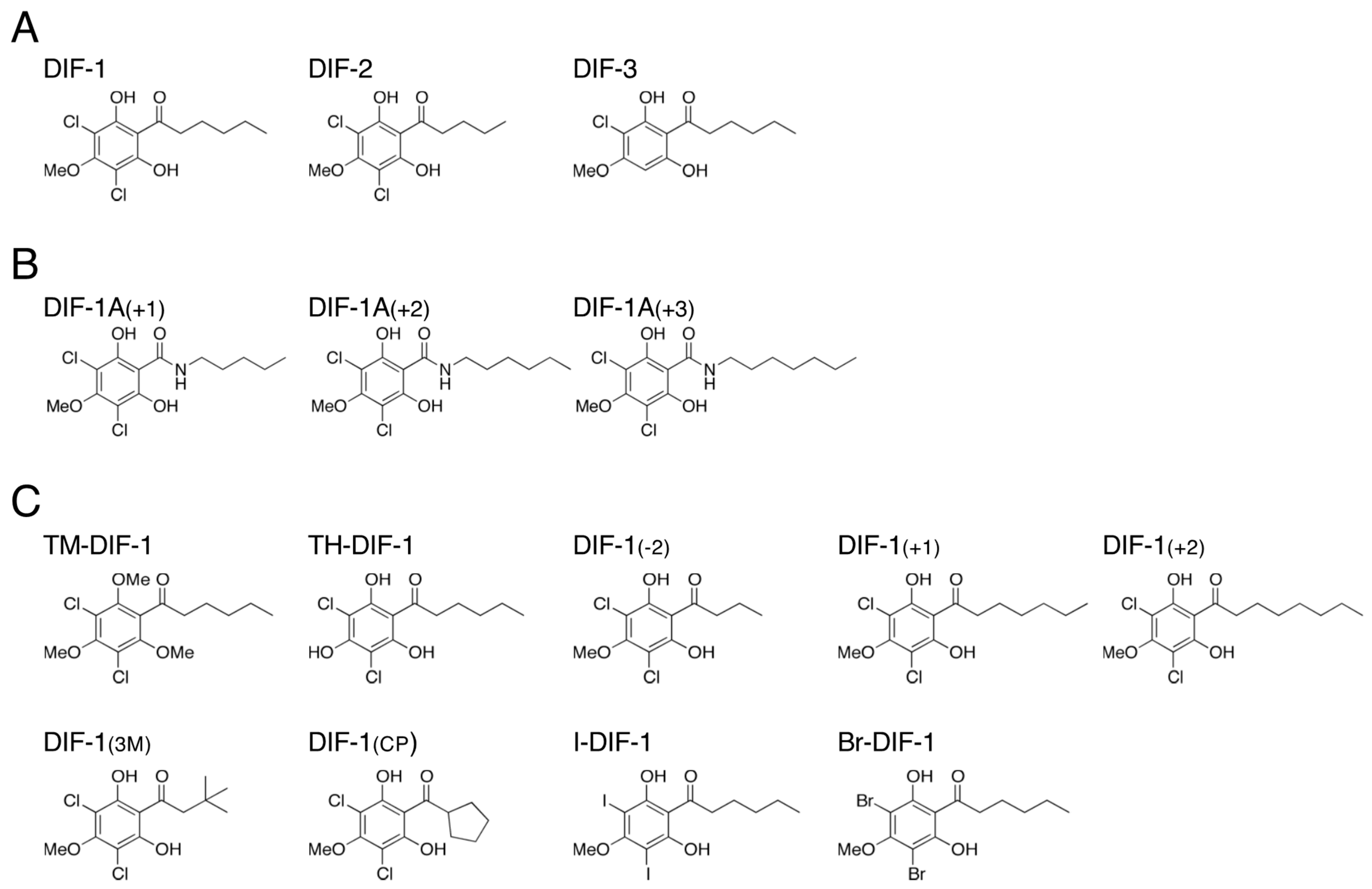
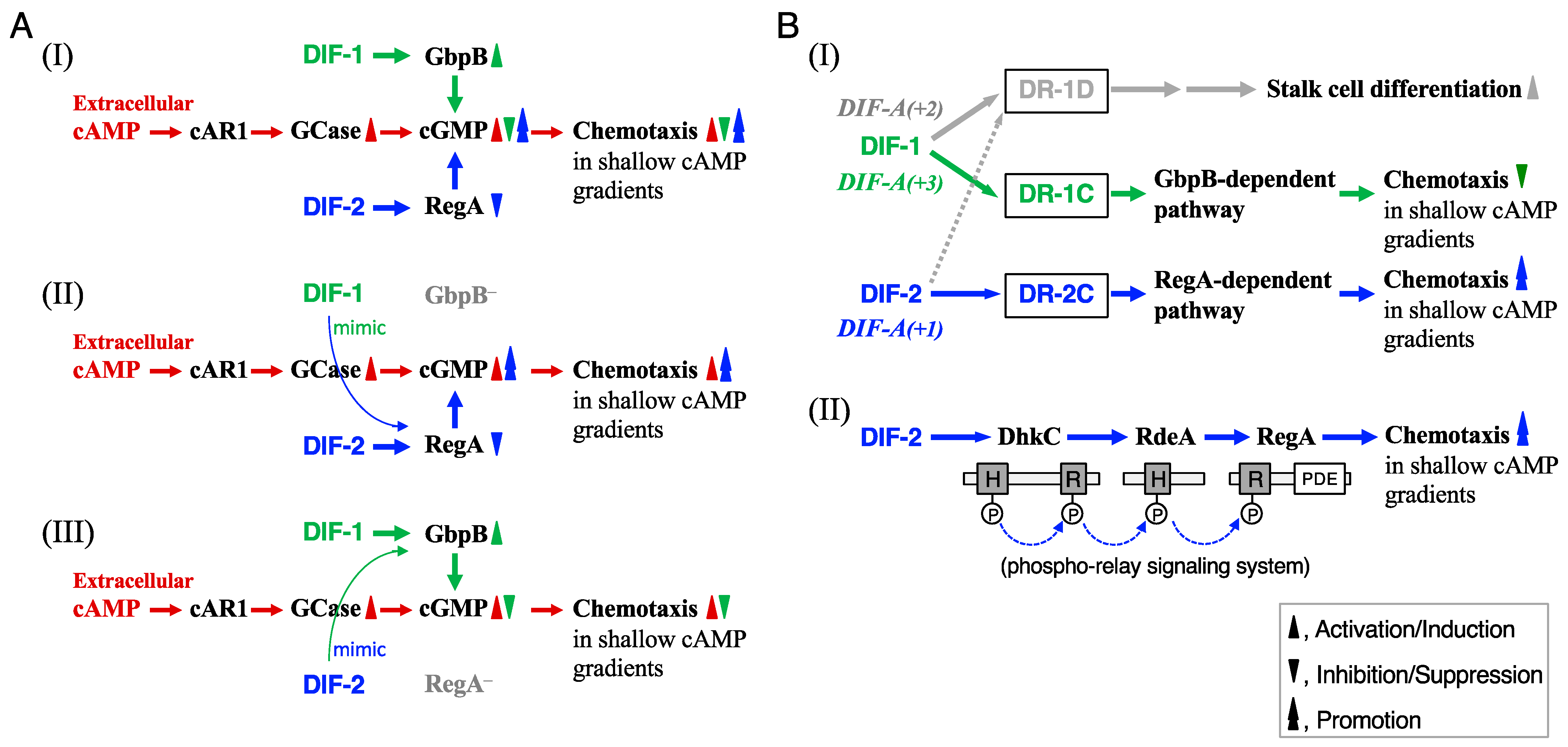
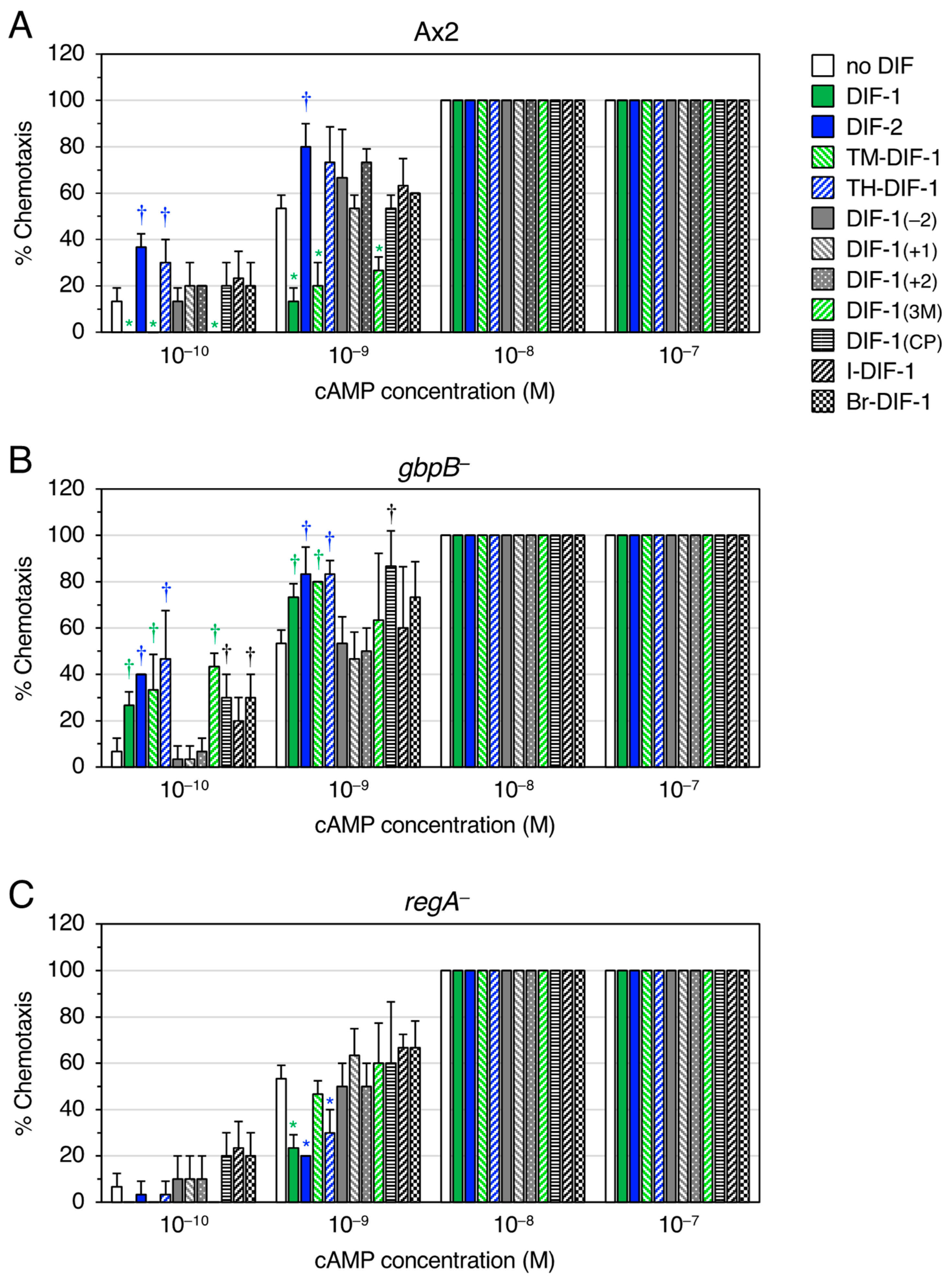
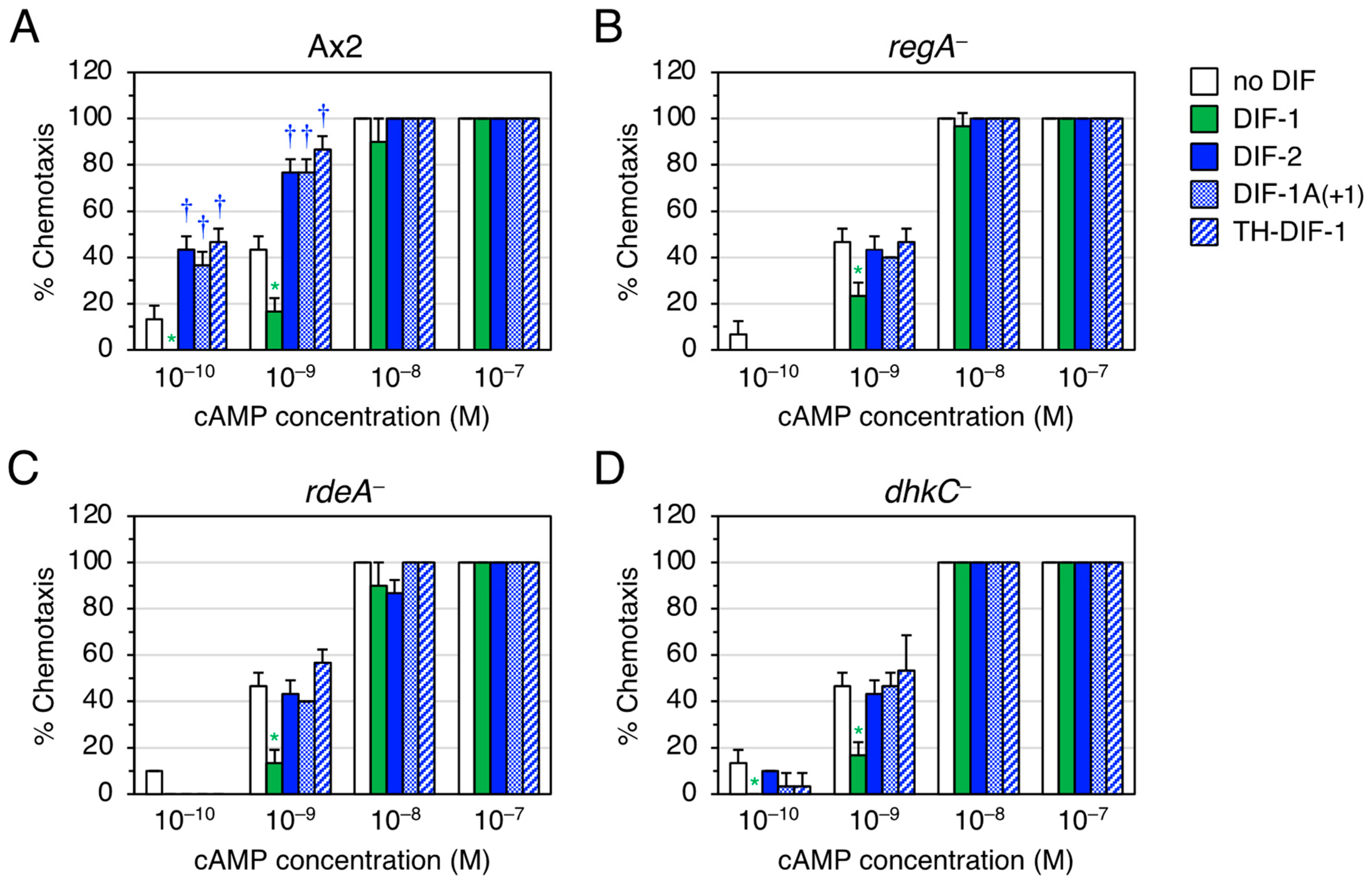
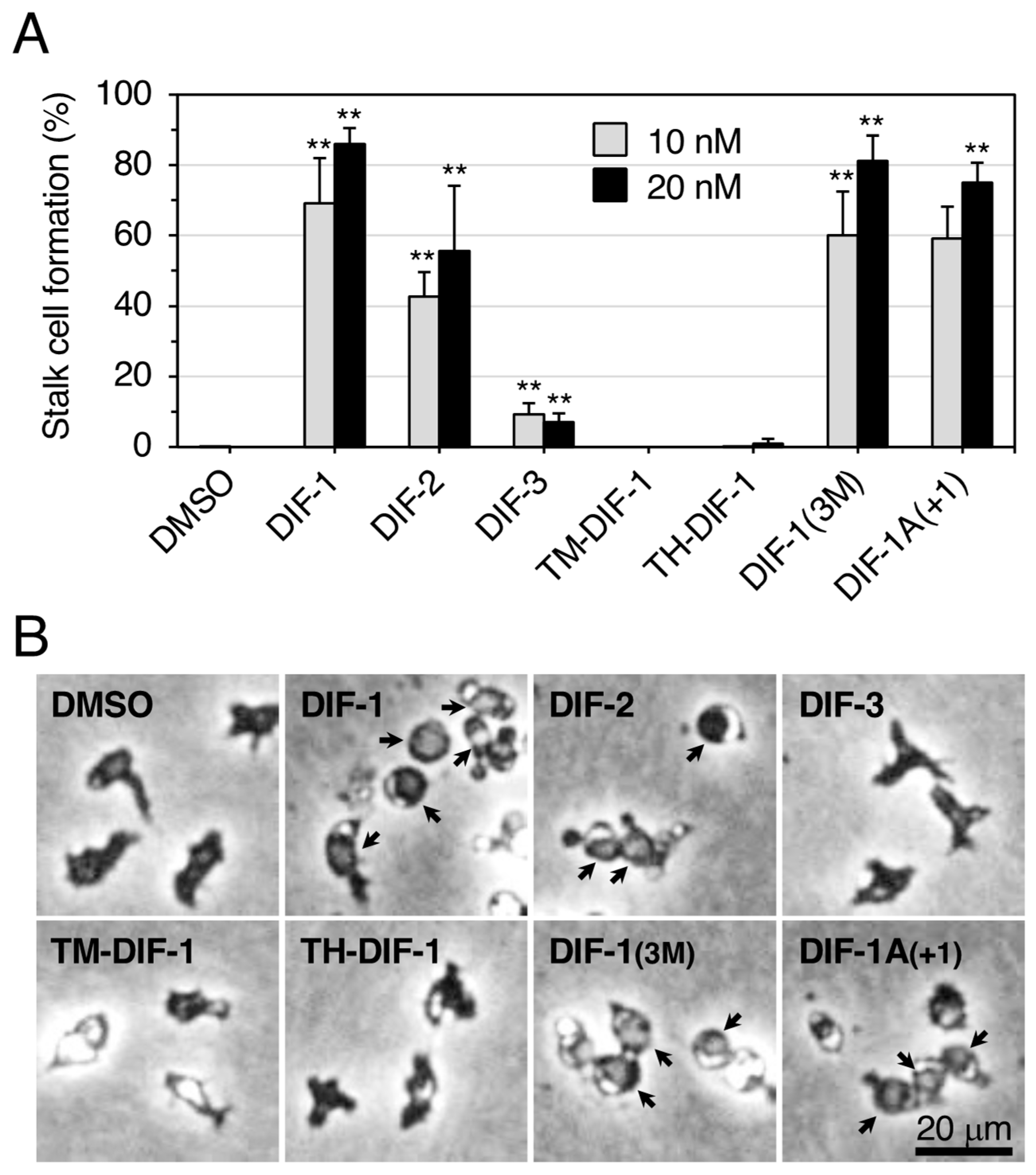
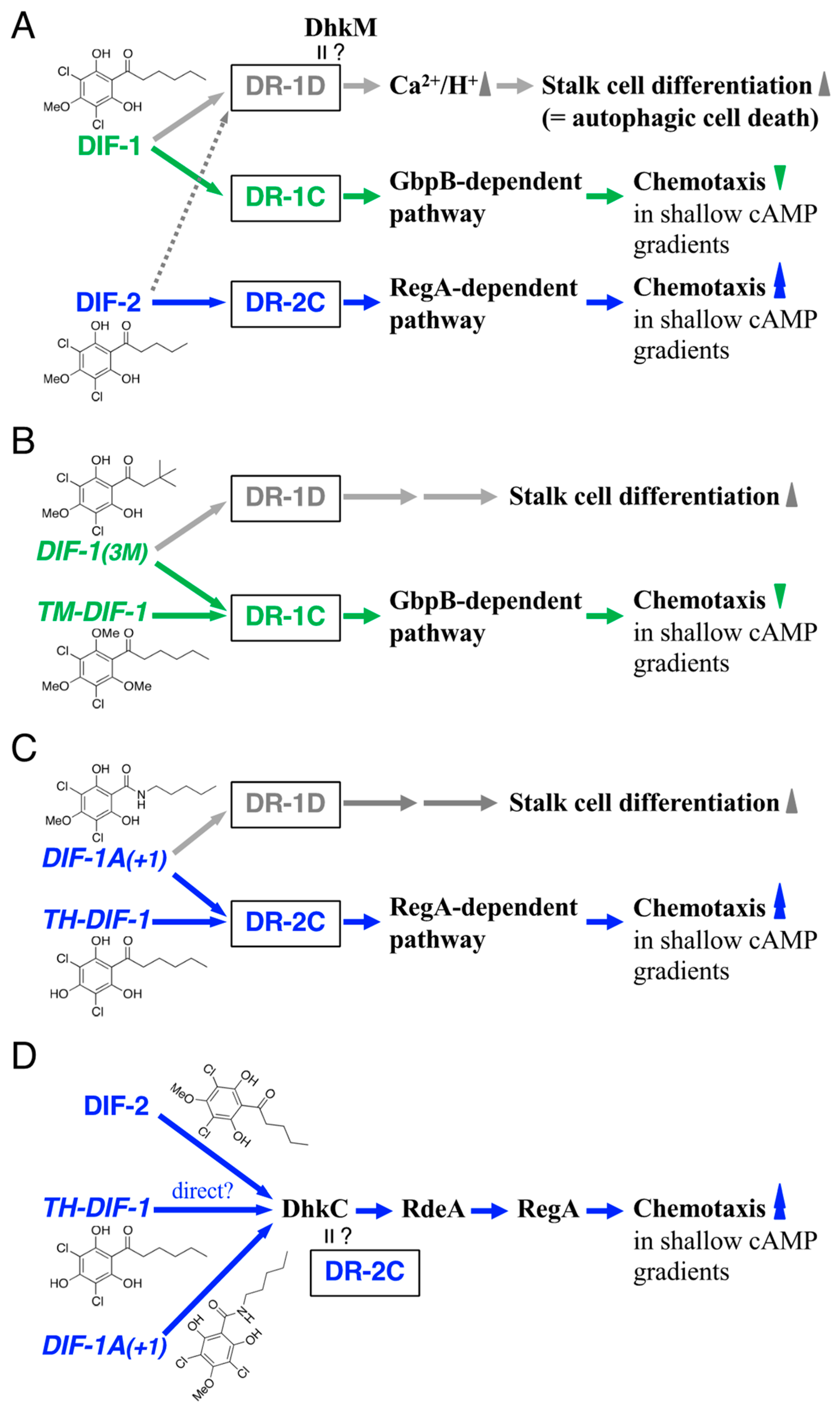
| Chemotaxis Modulation in | Stalk Cell Induction * in | ||||
|---|---|---|---|---|---|
| Compounds | MW | Ax2 Cells | HM1030 (dmtA−) Cells | HM44 Cells | cLogP *** |
| (100 nM DIFs) [Figure 3] | (20 nM DIFs) [Figure 5] | (2 nM DIFs) [26] | |||
| DIF-1 | 307.17 | 🠳 | +++++ | +++++ | 3.278 |
| DIF-2 | 293.14 | 🠱 | +++ | ++++ | 2.749 |
| DIF-3 | 272.73 | ne [10] | ± | ± | 2.895 |
| TM-DIF-1 | 335.22 | 🠳 | ± | ± | 4.190 |
| TH-DIF-1 | 293.14 | 🠱 | ± ** | +++++ ** | 2.592 |
| DIF-1(-2) | 279.11 | ne | nd | + | 2.220 |
| DIF-1(+1) | 321.19 | ne | nd | ++++ | 3.807 |
| DIF-1(+2) | 335.22 | ne | nd | ++++ | 4.336 |
| DIF-1(3M) | 307.17 | 🠳 | +++++ | +++++ | 3.018 |
| DIF-1(CP) | 305.15 | ne | nd | ++++ | 2.634 |
| I-DIF-1 | 490.08 | ne | nd | + | 4.008 |
| Br-DIF-1 | 396.08 | ne | nd | +++ | 3.678 |
| (10~100 nM DIFs) [11] | (10 nM DIFs) [11] | (0.5 nM DIFs) [19] | |||
| DIF-1A(+1) | 322.18 | 🠱 | ++++ | ++++ | 3.048 |
| DIF-1A(+2) | 336.21 | ne | ++++ | +++ | 3.577 |
| DIF-1A(+3) | 350.24 | 🠳 | ± | ± | 4.106 |
Disclaimer/Publisher’s Note: The statements, opinions and data contained in all publications are solely those of the individual author(s) and contributor(s) and not of MDPI and/or the editor(s). MDPI and/or the editor(s) disclaim responsibility for any injury to people or property resulting from any ideas, methods, instructions or products referred to in the content. |
© 2023 by the authors. Licensee MDPI, Basel, Switzerland. This article is an open access article distributed under the terms and conditions of the Creative Commons Attribution (CC BY) license (https://creativecommons.org/licenses/by/4.0/).
Share and Cite
Kuwayama, H.; Kikuchi, H.; Kubohara, Y. Derivatives of Differentiation-Inducing Factor 1 Differentially Control Chemotaxis and Stalk Cell Differentiation in Dictyostelium discoideum. Biology 2023, 12, 873. https://doi.org/10.3390/biology12060873
Kuwayama H, Kikuchi H, Kubohara Y. Derivatives of Differentiation-Inducing Factor 1 Differentially Control Chemotaxis and Stalk Cell Differentiation in Dictyostelium discoideum. Biology. 2023; 12(6):873. https://doi.org/10.3390/biology12060873
Chicago/Turabian StyleKuwayama, Hidekazu, Haruhisa Kikuchi, and Yuzuru Kubohara. 2023. "Derivatives of Differentiation-Inducing Factor 1 Differentially Control Chemotaxis and Stalk Cell Differentiation in Dictyostelium discoideum" Biology 12, no. 6: 873. https://doi.org/10.3390/biology12060873
APA StyleKuwayama, H., Kikuchi, H., & Kubohara, Y. (2023). Derivatives of Differentiation-Inducing Factor 1 Differentially Control Chemotaxis and Stalk Cell Differentiation in Dictyostelium discoideum. Biology, 12(6), 873. https://doi.org/10.3390/biology12060873







